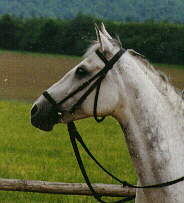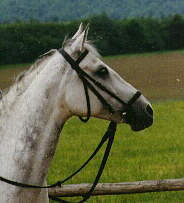Rhythm and Regularity
Both rhythm and regularity should be the same on straight and bending lines, through lateral work, and through transitions. Rhythm refers to the sequence of the footfalls, which should only include the pure walk, pure trot, and pure canter (except for the canter pirouette, where the horse naturally makes his canter four-beat). The regularity, or purity, of the gait includes the evenness and levelness of the stride.
Relaxation
The second level of the pyramid is relaxation (looseness). Signs of looseness in the horse may be seen by an even stride that is swinging through the back and causing the tail to swing like a pendulum, looseness at the poll, a soft chewing of the bit, and a relaxed blowing through the nose. The horse will make smooth transitions, be easy to position from side to side, and will willingly reach down into the contact as the reins are lengthened
Contact
Contact - the third level of the pyramid - is the result of the horse’s pushing power, and should never be achieved by the pulling of the rider’s hands. The rider drives the horse into soft hands that allow the horse to come up into the bridle, and should always follow the natural motion of the animal’s head. The horse should have equal contact in both reins.
Impulsion
The pushing power (thrust) of the horse is called “impulsion,” and is the fourth level of the training pyramid. Impulsion is created by storing the energy of engagement (the forward reaching of the hind legs under the body). It is a result of:
• Correct driving aids of the rider
• Relaxation of the horse
• Thoroughness: the flow of energy through the horse from front to back and back to front. The musculature of the horse is connected, supple, elastic, and unblocked, and the rider’s aids go freely through the horse.
Impulsion only occurs in the trot and canter - not the walk - because it is associated with the moment of suspension found in these two gaits.
Straightness
A horse is straight when his hind legs follow the path of his front legs, on both straight lines and on bending lines, and his body is parallel to the line of travel. Straightness causes the horse to channel his impulsion directly toward his center of balance, and allows the rider’s hand aids to have a connection to the hind end.
Collection
At the apex of the training scale, collection may be used occasionally to supplement less vigorous work, but is only focused on (through the collected gaits and more difficult movements, such as flying changes) in more advanced horses. Collection requires greater muscular strength, so must be developed slowly.
When a horse collects, he naturally takes more of his weight onto his hindquarters. The joints of the hind limbs have greater flexion, allowing the horse to lower his hindquarters, bring his hind legs further under his body, and lighten the forehand. A collected horse is able to move more freely. When collected, the stride length should shorten, and increase in energy and activity.



